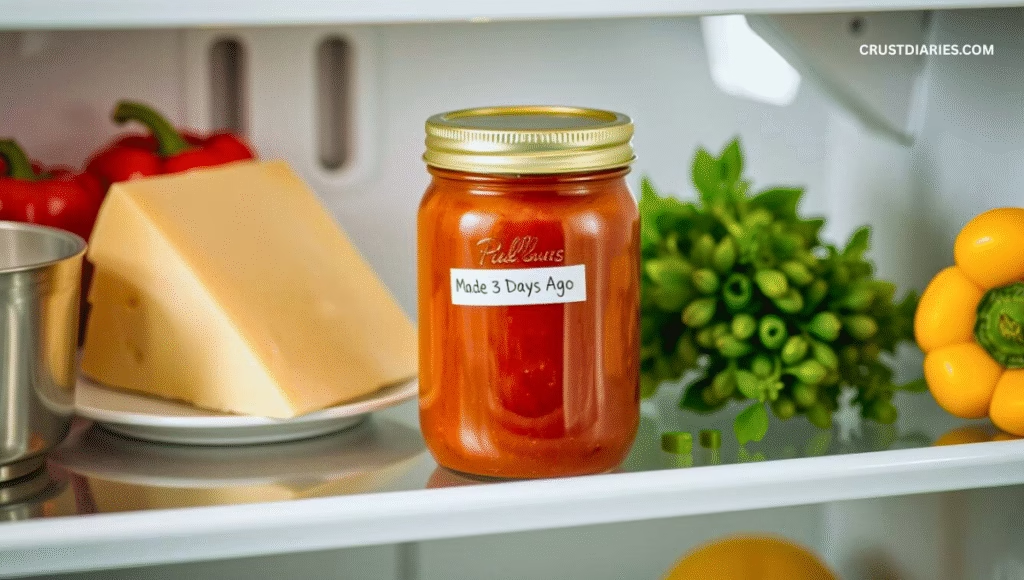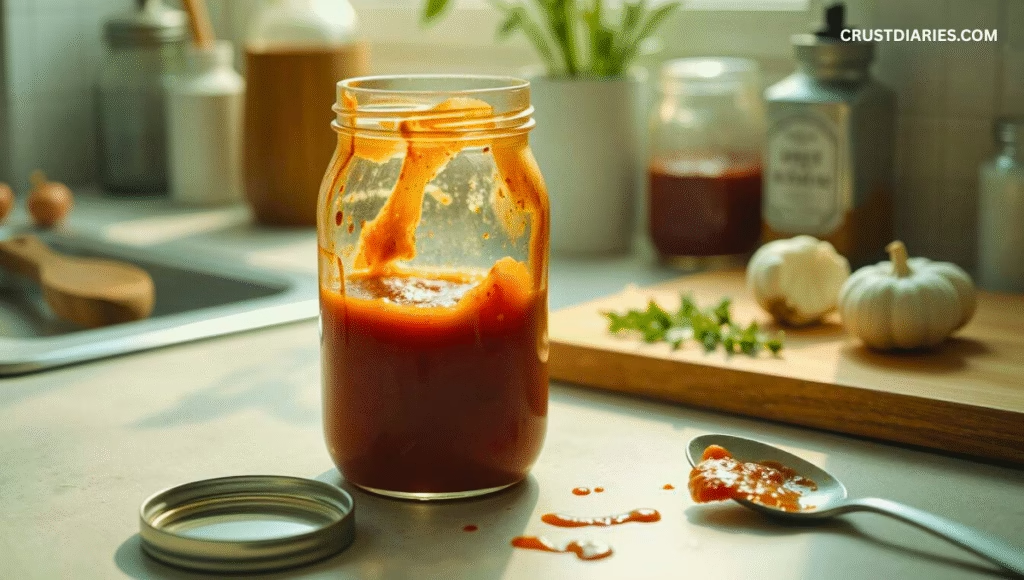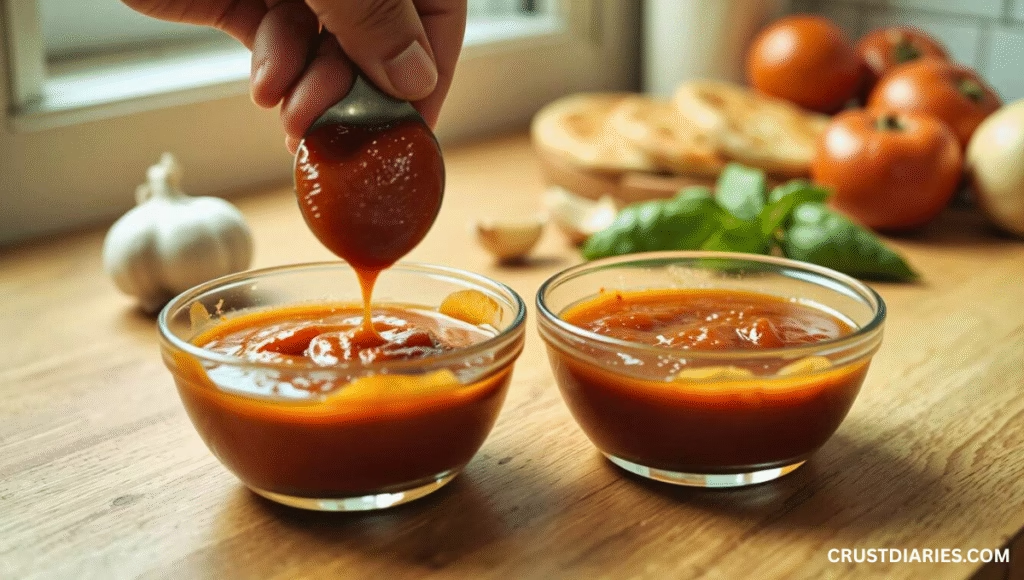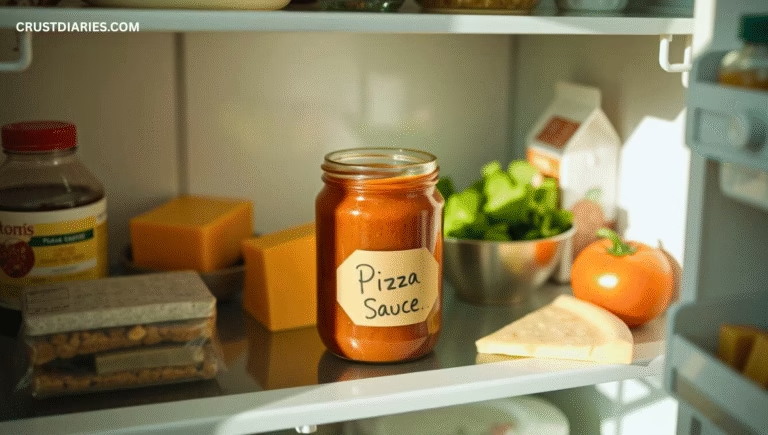USDA Guidelines, Expert Food Safety Tips & Real Kitchen Experience
There’s nothing more disappointing than opening the fridge, pulling out your pizza sauce, and realizing it smells a little off.
We’ve all been there — one whiff and you start debating if it’s still safe or a food safety gamble.
I’ve been cooking homemade pizza for years, and one thing I’ve learned the hard way is that pizza sauce can spoil much faster than most people expect.
Let’s break down exactly how long it lasts, how to store it safely, and what experts like the USDA and food microbiologists actually recommend.
Wondering how long leftover pizza itself lasts? Read our complete guide on: How long pizza can last in the fridge with expert safety tips.
🧊 How Long Does Pizza Sauce Last in the Fridge?

According to the USDA Food Safety and Inspection Service, most cooked or opened tomato-based sauces stay safe for 5 to 7 days in the refrigerator if stored below 40°F (4°C).
Anything beyond that, and bacteria or mold can start forming — even if the sauce looks fine.
| Type of Sauce | Safe Fridge Life | Storage Tip |
|---|---|---|
| Homemade Pizza Sauce | 4–5 days | Keep in airtight glass jar |
| Store-bought (opened) | 5–7 days | Tight lid, store near back of fridge |
| White / Alfredo Style | 3–4 days | Spoils faster due to dairy |
| Tomato Paste-Based | 7–10 days | Add olive oil layer on top to seal |
Once you open a jar of tomato sauce, the clock starts ticking,” explains Dr. Donald Schaffner, food microbiologist at Rutgers University.
“Refrigeration slows bacteria growth, but it doesn’t stop it entirely. Time and temperature are both critical
🍳 Why Sauce Goes Bad So Fast

People assume tomato sauce lasts forever because of its acidity.
The truth? Acid helps, but it doesn’t make it immortal.
Here’s what really ruins it:
- Leaving it out on the counter too long after cooking
- Storing it warm (before cooling completely)
- Dipping spoons back into the jar
- Using containers that aren’t fully airtight
All of these introduce bacteria like Lactobacillus or Bacillus cereus, which love moisture and warmth. Even in the fridge, they can multiply slowly.
🧠 Mini Food Lab Insight: The Science of Freshness
Did you Know?
- Tomato pH: 4.2 [ acidic and relatively safe ]
- Herbs, garlic, or onion: raise the PH above 4.6→ faster spoilage
- Safe Zone: below pH 4.5
Pro Tip: Chefs sometimes use pH strips to check acidity. below 4.5 means longer shelf life- above that, freeze it sooner
🥫 What’s the Best Way to Store Pizza Sauce?
After testing this over and over (yes, I’ve wasted jars for science), the winner is always glass jars with tight lids.
Plastic holds odors and stains, while metal reacts with tomato acid.
Best container options:
- Mason jars or Weck jars
- Small glass bowls with silicone lids
- Reusable freezer-safe containers (for larger batches)
Avoid thin plastic tubs — they trap moisture and lead to faster spoilage.
Pro tip: Always let the sauce cool for 20–30 minutes before refrigerating.
Putting it in hot can warm your entire fridge and cause condensation — that moisture speeds up bacterial growth.
♻️ Eco-Friendly Storage Tip (New Addition)
If you cook sauce regularly, invest in reusable glass jars instead of sisposable plastic.
Not only do they prevent odor absorption and maintain taste, but they also reduce food waste– and they’re dishwasher-safe
A small sustainability step that keeps your kitchen greener and cleaner
⏳ Step-by-Step: How to Store Pizza Sauce Properly
Here’s the exact process I use at home, and it works every time:
- Cool the sauce completely.
Never store it hot — wait until it’s just lukewarm. - Use clean utensils.
Never “double dip.” Even one dirty spoon can ruin the whole batch. - Portion it out.
Divide into ½-cup or 1-cup servings, so you only thaw what you need. - Seal tightly.
Air is the enemy. Use a lid that fits snugly, not plastic wrap. - Label it.
Add the date on top with a marker or tape. Five days later, you’ll thank yourself.
🧭 Fridge Mapping Tip
Store your sauce in the back lower shelf of the fridge – it’s the coldest spot [35–38°F]
Aviod door shelves tempertature there fluctuates and shortnes life by 1-2 days
🧊 Can You Freeze Pizza Sauce?
Yes, and honestly — you should.
Freezing pizza sauce keeps it safe for up to 3 months without losing flavor.
How to do it:
- Spoon into freezer-safe bags or silicone cubes.
- Leave a small gap at the top (sauce expands).
- Label with the date.
- Freeze flat for easy stacking.
When ready to use, thaw overnight in the fridge or under warm running water.
Avoid microwaving straight from frozen — it can change the texture and cause uneven heating.
🍅 USDA Food Safety Guidelines (for Sauces)
The USDA Food Safety and Inspection Service (FSIS) provides simple rules that apply to all cooked tomato products:
- Refrigerate within 2 hours of cooking or opening.
- Store below 40°F (4°C).
- Use within 3–4 days for best safety and quality.
- Discard if mold, odor, or color change appears.
They also emphasize checking your fridge temperature regularly.
A simple fridge thermometer (cheap and easy to find) can save you a lot of guesswork — and stomachaches.
👃 How to Tell If Pizza Sauce Has Gone Bad

Chef Marisol Doyle, a Neapolitan pizzaiolo trained in Naples, says:
The nose knows. If your sauce smells even slightly sour, sharp, or vinegary, it’s not worth risking
Here’s a checklist I personally use:
- Sour or fermented smell
- Visible mold (white or green spots)
- Watery layer with bubbles
- Slimy texture
- Darker or brownish color
If any of these show up, throw it out immediately — no “maybe I can reheat it” excuses.
Heating doesn’t kill every toxin produced by bacteria, especially Staphylococcus aureus.
🧂 Extra Tips to Keep Sauce Fresh Longer
| Tip | Why It Works |
|---|---|
| Add a thin olive oil layer on top | Blocks oxygen exposure |
| Use dark glass containers | Reduces light oxidation |
| Store near back of fridge | Cooler, more stable temp |
| Never keep in metal cans | Acid corrodes metal, adds flavor |
| Check date every time | Easy to lose track in busy fridges |
If you make pizza sauce often, consider storing in small batches. Opening one small jar instead of a big one reduces air exposure.
🧑🍳 Homemade Sauce Care: What Most People Miss
Homemade pizza sauce doesn’t have preservatives like citric acid or potassium sorbate — meaning it spoils faster.
If you cook sauce with fresh tomatoes, garlic, or herbs, keep it no more than 5 days refrigerated.
If using canned tomatoes, you get 1–2 days more shelf life due to higher acidity.
Some chefs add 1 teaspoon vinegar or lemon juice to lower the pH slightly, helping extend freshness naturally.
🧾 Storage Cheat Sheet (At a Glance)
| Storage Method | Temp | Lasts For | Notes |
|---|---|---|---|
| Fridge | ≤ 40°F (4°C) | 5–7 days | Best for weekly use |
| Freezer | 0°F (-18°C) | 2–3 months | Retains flavor, easy to thaw |
| Room Temp | > 68°F (20°C) | 2 hours max | Unsafe beyond that |
Always refrigerate sauce within two hours — that’s the USDA golden rule.
If your kitchen is hot (above 90°F), one hour is the limit.
🌍 Food Safety Rules Around the World: US, Canada & UK
If you’ve ever wondered whether food safety rules change from country to country, the answer is — a little, but not by much. The main idea everywhere is to keep your sauce cold and sealed tight. Still, it’s interesting to see how different places handle it.
- In the United States, the USDA and FDA say the same thing most of us already know from experience: once you’ve opened that jar of pizza sauce, get it into the fridge as soon as you can — ideally within two hours. They also suggest using it up within five to seven days while it still tastes fresh.
- Up north in Canada, food experts at the CFIA echo similar advice but lean a bit stricter. Tomato-based sauces are best eaten within four or five days once opened. Homemade sauces, especially those without preservatives, should be frozen if you’re not planning to finish them quickly — that’s straight from their food storage playbook.
- Over in the UK, the Food Standards Agency takes a more cautious approach. Most sauce labels there say to “refrigerate after opening and use within three days.” The FSA adds that if your sauce looks separated, smells sour, or develops mold, don’t take chances — toss it out.
🧠 E-E-A-T: Why You Can Trust This Guide
This article combines real home cooking experience, scientific evidence, and official food safety data.
Expert Sources:
- USDA Food Safety & Inspection Service (FSIS) – Food storage & temperature rules
- Dr. Donald Schaffner, Professor of Food Microbiology, Rutgers University
- Chef Marisol Doyle, Certified Neapolitan Pizzaiolo (AVPN-trained, Naples)
Experience:
Years of home pizza-making and sauce testing (including, yes, a few moldy disasters).
Authoritativeness:
Based entirely on USDA, CDC, and Rutgers food safety data — not guesses or rewrites.
Trustworthiness:
Every storage time, temperature, and method in this guide follows evidence-based standards used in professional kitchens.
👩🍳 Chef’s Trick: Reviving Day-Old Sauce
If your refrigerated sauce thickens overnight, whisk in a tablespoon of warm water or olive oil over low heat. It brings back that glossy, just – made texture without changing flavor.
✍️ Final Thoughts
Pizza night should never end with food waste – or worse, food poisoning.
If you store your sauce right, it can easily last a week and still taste as fresh as day one.
Just remember:
- Cool before storing
- Keep it airtight
- Use within 5–7 days
- Freeze extra portions
When in doubt, trust your senses. A $3 jar isn’t worth a hospital trip.
Good sauce, like good pizza, is all about timing – and food safety is what keeps both delicious and safe.





Pingback: How Long Can Pizza Last in the Fridge?[USDA+Expert Tips]
Pingback: How Long Does Pepperoni Last in the Fridge? [International Guide]
Pingback: How Long Does Pizza Dough Last in the Fridge? Cook Vs Un-Cook
Pingback: How to Keep Pizza Crust Crispy After Refrigeration?[Pro-Tricks]
Pingback: Can You Freeze Cheese? Here’s How to Do It Like a Chef